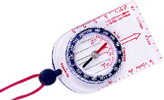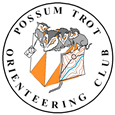Orienteering compasses
Bring an orienteering compass to the meet. The most common are the baseplate or protractor style compasses. They feature a baseplate which is aligned with your direction of travel, and a rotating housing which measures your bearing and houses the magnetic needle. Another feature to look for is the scale. Orienteering maps use 1:15,000 or 1:10,000 scales, but most compasses in local stores will have an inch and millimeter scale which, when used in conjunction with the scale on the map, will work just fine. Dick's Sporting Goods, the Kansas City Scout Shop, maybe even Walmart, Target should carry these types of compasses for $10 to $20. Or do a Google Search on "orienteering compass".
Clothing
Wear long pants and shirts, and shoes or boots suitable for off-trail walking or running. There are, of course, many orienteering gear suppliers but what you have in your closet will serve you well for your first few events. Avoid wearing sweat clothes; they tend to collect the "stick-tights" (those pesky little thorny seeds). Closely woven material or, even better, rip-stop nylon are good choices. Jeans are OK, but are uncomfortable when wet. Remember to "start cool" to avoid overheating later on the course.
Safety The worst hazards in the midwest are ticks, chiggers, and poison ivy. Spraying your ankles and waist with a good insect repellant will mitigate the first two hazards, and being alert for "leaves of three" should help avoid the third hazard. Check for ticks as soon as possible after the event. Hydrate before you go out on the courses. The longer courses have drinking water stops, but courses shorter than 3 kilometers may not. You may carry your own water. |
|



